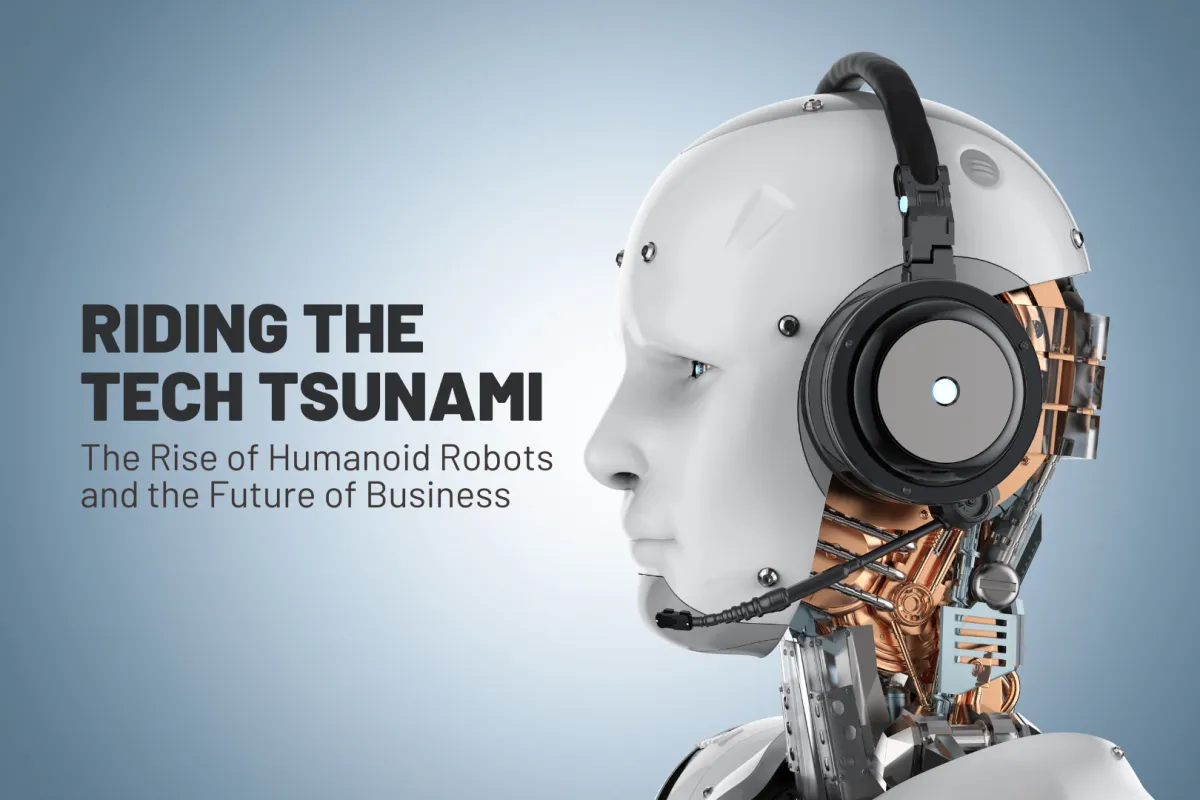Aaron's Blog
Blog Post Categories

Riding the Tech Tsunami: The Rise of Humanoid Robots and the Future of Business 🌊🤖
"The best way to predict the future is to invent it."
- Alan Kay
Introduction
In the ever-evolving landscape of technology, the emergence of humanoid robots is a testament to human ingenuity and innovation. Agility Robotics, a frontrunner in this domain, is on the brink of a technological revolution with its announcement of opening a humanoid robot factory. These robots, aptly named Digit, are not mere machines; they are designed to work in tandem with humans, seamlessly navigating intricate environments like warehouses and factories. As we stand on the cusp of this new era, it's imperative for business owners and executives to understand the profound implications of such advancements. The question isn't whether these robots will integrate into our workforce but how quickly they will reshape it. And in this rapidly changing scenario, ignorance isn't bliss; it's a business risk.
Background or History
While now becoming a tangible reality, the concept of humanoid robots has its roots deep in science fiction. For decades, authors and filmmakers envisioned a world where robots would walk, talk, and work alongside humans. Today, with companies like Agility Robotics leading the charge, this vision is becoming reality. The history of technological revolutions, be it the steam engine's advent or the rise of the internet, has always been marked by societal and industrial upheaval. Each revolution brought with it challenges and opportunities, winners and losers. The emergence of humanoid robots promises a similar transformative impact, making it crucial for businesses to understand and adapt to this new paradigm.
Key Challenges
The integration of humanoid robots into the workforce presents multifaceted challenges. Foremost is the potential displacement of jobs. As robots like Digit become more prevalent, many tasks traditionally reserved for humans might be automated. This shift could lead to significant job losses in sectors most vulnerable to automation. Furthermore, history has shown that companies resistant to technological evolution often face obsolescence. Kodak, Blockbuster, and many others are cautionary tales of businesses that failed to adapt to technological shifts. Beyond job displacement, there's the challenge of staying competitive. Businesses that lag in a market where competitors might leverage robot-driven efficiencies find themselves at a significant disadvantage.
Solutions and Recommendations
While the challenges are significant, they aren't insurmountable. Businesses must adopt a proactive approach. Embracing technology and understanding its broader implications will be key. One viable strategy is to invest in training programs upskilling workers to ensure they remain valuable in a robot-augmented workforce. Drawing insights from "Harness the Juice" by Aaron Alfini, it's evident that understanding the technological landscape is crucial. Alfini emphasizes the importance of recognizing the tech tsunami and navigating it effectively. For businesses, this means not just integrating technology but fostering a culture of continuous learning and innovation.
By the Numbers
The numbers surrounding the rise of humanoid robots are staggering. Agility Robotics' ambition to produce up to 10,000 humanoid robots annually is just the tip of the iceberg. Their expansive 70,000-square-foot RoboFab facility is a testament to this venture's scale and potential. But it's not just about robot production; the human element is equally significant. The venture promises to employ over 500 individuals, highlighting the symbiotic relationship between robots and humans. Beyond these figures, the broader industry projections are equally compelling. The global market for humanoid robots is expected to witness exponential growth in the coming years, driven by advancements in AI and machine learning.
Future Outlook
The horizon of humanoid robots is vast and promising. As technology continues its relentless march forward, integrating robots in various sectors will become commonplace. Beyond industrial applications, we might see humanoid robots in healthcare, assisting patients, or in education, aiding teachers. The potential applications are limitless. However, with these advancements come challenges. Regulatory frameworks will need to evolve, ethical considerations will come to the forefront, and businesses will have to navigate uncharted waters. But one thing is sure: companies that adapt, innovate, and ride the tech tsunami will be the ones shaping the future.
Conclusion
The path forward is clear at this technological crossroads: adapt or risk obsolescence. The tech tsunami, powered by humanoid robots and other advancements, is not a distant future event; it's happening now. Businesses, executives, and workers must come together, armed with knowledge and a proactive mindset, to navigate this new landscape. The stakes are high, but so are the rewards. The opportunities are boundless for those willing to embrace change, innovate, and look to the future with optimism. It's not just about surviving the tech tsunami; it's about harnessing its power for growth, progress, and prosperity.
Citations

Riding the Tech Tsunami: The Rise of Humanoid Robots and the Future of Business 🌊🤖
"The best way to predict the future is to invent it."
- Alan Kay
Introduction
In the ever-evolving landscape of technology, the emergence of humanoid robots is a testament to human ingenuity and innovation. Agility Robotics, a frontrunner in this domain, is on the brink of a technological revolution with its announcement of opening a humanoid robot factory. These robots, aptly named Digit, are not mere machines; they are designed to work in tandem with humans, seamlessly navigating intricate environments like warehouses and factories. As we stand on the cusp of this new era, it's imperative for business owners and executives to understand the profound implications of such advancements. The question isn't whether these robots will integrate into our workforce but how quickly they will reshape it. And in this rapidly changing scenario, ignorance isn't bliss; it's a business risk.
Background or History
While now becoming a tangible reality, the concept of humanoid robots has its roots deep in science fiction. For decades, authors and filmmakers envisioned a world where robots would walk, talk, and work alongside humans. Today, with companies like Agility Robotics leading the charge, this vision is becoming reality. The history of technological revolutions, be it the steam engine's advent or the rise of the internet, has always been marked by societal and industrial upheaval. Each revolution brought with it challenges and opportunities, winners and losers. The emergence of humanoid robots promises a similar transformative impact, making it crucial for businesses to understand and adapt to this new paradigm.
Key Challenges
The integration of humanoid robots into the workforce presents multifaceted challenges. Foremost is the potential displacement of jobs. As robots like Digit become more prevalent, many tasks traditionally reserved for humans might be automated. This shift could lead to significant job losses in sectors most vulnerable to automation. Furthermore, history has shown that companies resistant to technological evolution often face obsolescence. Kodak, Blockbuster, and many others are cautionary tales of businesses that failed to adapt to technological shifts. Beyond job displacement, there's the challenge of staying competitive. Businesses that lag in a market where competitors might leverage robot-driven efficiencies find themselves at a significant disadvantage.
Solutions and Recommendations
While the challenges are significant, they aren't insurmountable. Businesses must adopt a proactive approach. Embracing technology and understanding its broader implications will be key. One viable strategy is to invest in training programs upskilling workers to ensure they remain valuable in a robot-augmented workforce. Drawing insights from "Harness the Juice" by Aaron Alfini, it's evident that understanding the technological landscape is crucial. Alfini emphasizes the importance of recognizing the tech tsunami and navigating it effectively. For businesses, this means not just integrating technology but fostering a culture of continuous learning and innovation.
By the Numbers
The numbers surrounding the rise of humanoid robots are staggering. Agility Robotics' ambition to produce up to 10,000 humanoid robots annually is just the tip of the iceberg. Their expansive 70,000-square-foot RoboFab facility is a testament to this venture's scale and potential. But it's not just about robot production; the human element is equally significant. The venture promises to employ over 500 individuals, highlighting the symbiotic relationship between robots and humans. Beyond these figures, the broader industry projections are equally compelling. The global market for humanoid robots is expected to witness exponential growth in the coming years, driven by advancements in AI and machine learning.
Future Outlook
The horizon of humanoid robots is vast and promising. As technology continues its relentless march forward, integrating robots in various sectors will become commonplace. Beyond industrial applications, we might see humanoid robots in healthcare, assisting patients, or in education, aiding teachers. The potential applications are limitless. However, with these advancements come challenges. Regulatory frameworks will need to evolve, ethical considerations will come to the forefront, and businesses will have to navigate uncharted waters. But one thing is sure: companies that adapt, innovate, and ride the tech tsunami will be the ones shaping the future.
Conclusion
The path forward is clear at this technological crossroads: adapt or risk obsolescence. The tech tsunami, powered by humanoid robots and other advancements, is not a distant future event; it's happening now. Businesses, executives, and workers must come together, armed with knowledge and a proactive mindset, to navigate this new landscape. The stakes are high, but so are the rewards. The opportunities are boundless for those willing to embrace change, innovate, and look to the future with optimism. It's not just about surviving the tech tsunami; it's about harnessing its power for growth, progress, and prosperity.
Citations
Copyright 2026. All rights reserved
Testimonials

Lorem ipsum dolor sit amet, consectetur adipiscing elit, sed do eiusmod tempor incididunt ut labore et dolore magna aliqua. Ut enim ad minim veniam, quis nostrud exercitation ullamco laboris nisi ut aliquip ex ea commodo consequat.
JANE DOE

Lorem ipsum dolor sit amet, consectetur adipiscing elit, sed do eiusmod tempor incididunt ut labore et dolore magna aliqua. Ut enim ad minim veniam, quis nostrud exercitation ullamco laboris nisi ut aliquip ex ea commodo consequat.

